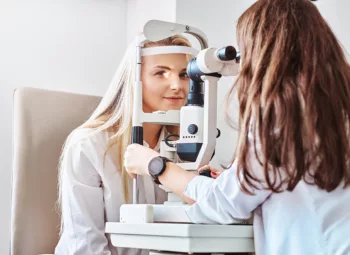
If you’re experiencing episodes of vision disturbances accompanied by headaches, you might be dealing with an ocular migraine. In this guide, we explain what an ocular migraine is, typical symptoms, some of the most common causes, and treatment options to consider with your eye doctor.
Ocular Migraines Explained
Ocular migraines are spells of vision changes sometimes followed by a severe headache. While the vision symptoms of an ocular migraine can be a warning sign of a server headache coming on, it’s also very common to have an episode without any headache symptoms at all. The length of time you experience the vision symptoms of an ocular migraine can also vary, lasting anywhere from five minutes to an hour or more.
Here are some common symptoms of an ocular migraine:
- Blind spots in the center of your vision
- Blurry vision or decreased vision
- Floating lines or other shapes obscuring your field of vision
- Tunnel vision
- Lights flicker in vision (starburst effect or seeing stars)
- Nausea or vomiting
- Anxiety
Changes in your vision should never be ignored, especially if these symptoms come on suddenly or occur intermittently. This can indicate a number of serious eye conditions, and health concerns, making it incredibly important to see an eye doctor as soon as possible. It’s also important to tell your eye doctor if you are experiencing vision changes in only one of your eyes or both of them. This key detail will help determine what type of ocular migraine you are experiencing.
Types of Ocular Migraines

There are two types of ocular migraines: a migraine with aura which is a common condition, and retinal migraines which are much less prevalent. The symptoms of these two types of ocular migraines are almost identical, except that a migraine with aura will affect both eyes while a retinal migraine affects only one.
Migraine with Aura
It’s estimated that around 20%-30% of people who are prone to migraines experience migraine aura. While migraine auras typically present as a visual disturbance in both eyes such as starbursts or blind spots, they can also affect any of your other senses as well and cause:
- Physical numbness (often in your face or hands)
- Slurred speech or difficulty speaking
- Ringing in your ears (tinnitus)
- Changes in your sense of smell
- Changes in your sense of taste
Some patients with migraine aura also report feeling dizzy, confused, or disoriented during episodes.
Retinal Migraine
Retinal migraines are a much rarer type of ocular migraine that are estimated to affect only one in every 200 people (0.50%) who are prone to migraines. During a retinal migraine, vision symptoms will only affect one eye but can be more intense and disruptive than common aura symptoms, including causing temporary blindness. These intrusive vision symptoms can occur either before or during the headache part of a migraine episode.
Common Causes of Ocular Migraines

While there is no definite answer to what causes ocular migraines, some theories suggest that the visual symptoms may be caused by reduced blood flow to the retina or changes in the nerve cells that spread across the retina. Some researchers propose that genetic factors play a role in someone’s susceptibility to ocular migraines as well.
Like most headaches and other kinds of migraines, there are a number of things that can potentially trigger an ocular migraine.
Some common triggers of ocular migraines include:
- Stress
- Outdated vision prescriptions
- Dehydration
- Hypertension
- Hypoglycemia (low blood sugar)
- Smoking
- Excessive alcohol, chocolate, or caffeine consumption
- Bright or flashing lights
- Too much or too little sleep
- Hormonal contraceptive pills (Birth Control Pills)
- Excessive heat
- High altitudes
- And more
Avoiding these common ocular migraine triggers is a good way to lower your risk of an attack, but to ensure the longevity of your vision and eye health it’s important to consult your eye doctor to determine the best treatment for you.
Ocular Migraine Treatment Options
If you experience the visual symptoms of an ocular migraine, it’s best to stop what you’re doing and rest until your vision returns to normal. If headache or migraine symptoms begin, continue to rest, do your best to remain hydrated, and take a pain reliever approved by your doctor.
Placing a cold cloth or ice pack on your head or back of the neck, and resting in cool, dark place away from bright lights and loud sounds can also be effective ways to find relief. Keeping your vision prescription updated, quitting smoking, limiting screen time, and avoiding your biggest triggers are the best ways to reduce your risk of ocular migraines overall.
If you think you’re experiencing ocular migraines, getting help from a healthcare professional is highly advised. A comprehensive eye exam by a certified ophthalmologist will rule out any other common eye conditions, and help you find the best treatment options for your specific needs.
Schedule an Appointment with an Eye Doctor at the First Sign of Vision Changes
Ocular migraines refer to a type of migraine characterized by vision disturbances in either one or both of your eyes, and occasionally other symptoms, such as nausea, dizziness, and head pain. If you’re experiencing any changes in your vision, accompanied by a headache or not, it’s important to contact an eye doctor as soon as possible. Use the form below to schedule a comprehensive eye exam in Union City with an ophthalmologist at NeoVision Eye Center today or call 1-510-431-5511.
Schedule a Comprehensive Eye Exam Today
Fill out the form below to schedule an eye exam with an ophthalmologist at NeoVision.
"*" indicates required fields





